Ranunculus: planting and care, flower cultivation
 Ranunculus (lat. Ranunculus), or buttercup, is a plant of family Ranunculaceae native to Asia Minor. Its name was given by an ancient scholar Pliny meaning "a frog" in Latin since many species of buttercup prefer marshland as all amphibians do. Ranunculus was brought to England from Turkey in the 16th century and soon it became a favorite flower of gardeners, but by the end of the 19th century its popularity had somewhat decreased and it was revived only in the current century.
Ranunculus (lat. Ranunculus), or buttercup, is a plant of family Ranunculaceae native to Asia Minor. Its name was given by an ancient scholar Pliny meaning "a frog" in Latin since many species of buttercup prefer marshland as all amphibians do. Ranunculus was brought to England from Turkey in the 16th century and soon it became a favorite flower of gardeners, but by the end of the 19th century its popularity had somewhat decreased and it was revived only in the current century.
Today there are more than 600 species of ranunculus. Ranunculus flower can stay fresh in a vase with water up to two weeks. In Italy buttercup is called "golden buttons of meadows." A beautiful legend has it that buttercups are small stars that were turned to the flowers by Jesus and presented to his mother as a sign of respect and love...
Ranunculus flowers
Buttercup
is a very beautiful flower. It is grown in the garden and in the pots at home decorating terraces, balconies and living rooms. The plant reaches a height of 8-32 inches. It has deeply lobed leaves and strong stems. Rhizomes are tubers looking like goose feet. Stocky rhizome, leaves and stems of ranunculus look like the leaves, stems and roots of dahlia. Lovely double, semi-double and heavy double inflorescences of different colors, except blue and light blue, reach 2-4 inches in diameter and in turn bloom from May to August. When they begin to open, they look like roses, and when they are fully opened, they look like double poppies. White ranunculus and pink ranunculus are very popular among brides and they are often used in wedding bouquets. However, you should keep in mind that ranunculus juice is poisonous.
In a culture species and varieties of ranunculus asiaticus are grown. Initially it has two varieties: Persian buttercup (Ranunculus Persian), the blossoms of which look like a rose, and turban buttercup (Ranunculus africanus) that resembles peony blossoms.
Peculiarities of ranunculus growing
- in order not to burn the roots while feeding ranunculus, apply only those fertilizers that include vermicompost;
- the plant does not like transplanting, so it is better not to worry ranunculus without extreme need;
- during flowering ranunculus needs potassium and limestone;
- during flowering, place the pot with a plant in shade and reduce watering for ranunculus to bloom longer;
- ranunculus is not cold hardy, so it is necessary to dig the tubers out of the ground before frosts as soon as its leaves wither away;
- you can plant buttercups of different colors in one pot and you get a beautiful and elegant bouquet;
- it is better to remove faded inflorescences for the new ones to start blooming faster, and in late summer the stem should be cut up to the ground.
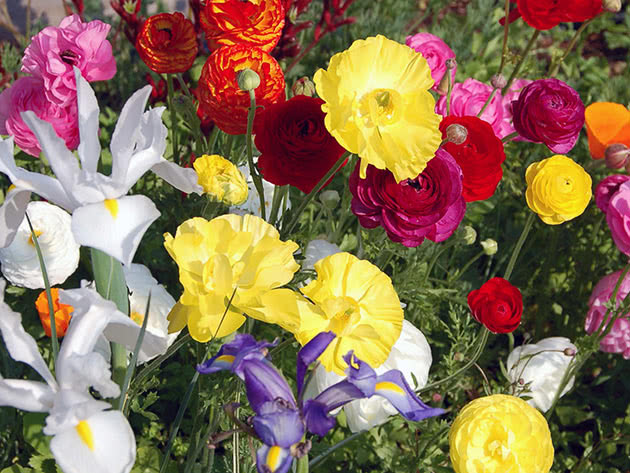
How to grow ranunculus in the garden
Preparation of soil for planting
Buttercup can tolerate direct sunlight, but still it prefers partial shade in which the color of its inflorescence becomes brighter and it blooms longer. It should be protected from drafts. Before planting, you should be sure that there will be no frosts any more. Ranunculus prefers a neutral, light and fertile soil, for instance, black soil with sand and humus, or peat neutralized with chalk. You should avoid using of loamy soil. The main thing is that soil should absorb water without moisture stagnation in the soil. It is necessary to arrange a good drainage, otherwise your flowers may rot. This can be done, for example, by adding a little of sand into the planting hole. Before planting of ranunculus, dig the soil over, add compost into it and treat it with fungicide.

When to sow ranunculus seeds
It is not easy to grow ranunculus from seeds, therefore, do not count on this method: ranunculus seeds have a very low germination. But if you want to know how to grow ranunculus from seeds, we are ready to share our experience and knowledge with you. It is better to take ranunculus seeds from the first blooming buds by wrapping them with gauze after they faded for the seeds not to fall on the ground. In mid-February sow them in a light fertile soil and cover with soil layer 0.6-0.8 inch thick. Cover the container with glass or foil and keep it in a well-lit place with a temperature of 59-63 ºF. From time to time moisten the soil. After two or three weeks, when there are shoots, remove the cover, and when the seedlings get two pairs of leaves, they are pricked out into separate pots, and when there is a warm weather, they are planted in the ground. They will bloom only in the next year, so ranunculus growing from seeds is not suitable for flower growers that count on quick results.
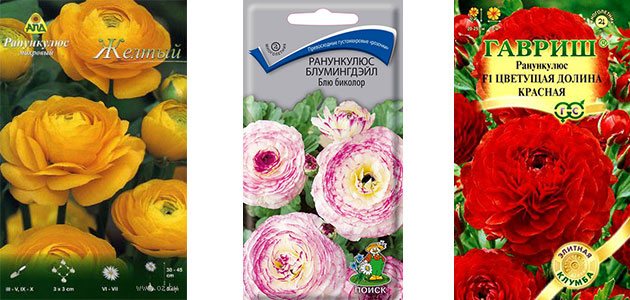
When to plant ranunculus tubers
When the soil gets warmed and there is no risk of spring frost (around the end of April or early May), it is time to plant bulbs of ranunculus. Planting of ranunculus flower is a simple and easy process, but there are some important points that should not be missed. To get ranunculus tubers prepared for planting, they are placed in a moist condition (sponge, wet sawdust or moss) for several hours. You can simply soak them in a cold water or in a weak solution of potassium permanganate. Sometimes growth stimulant can be added into water. Since the plant does not tolerate transplanting, you should think well how to plant ranunculus correctly at once, that is, what site will be really comfortable for the plant. How to plant ranunculus? Ranunculus tubers are placed in the hole at a depth of 2-3 inches. The distance between tubers should be 4-6 inches. If there is a chance of a sharp temperature drop, cover the flower bed with a frost protection fabric or straw. In two-three months, there will be several stems growing from each tuber, and later the first flowers of ranunculus will bloom.
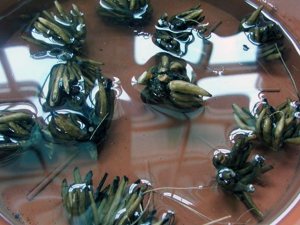
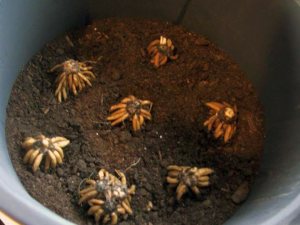
Ranunculus: care in the garden
Care for ranunkulus is quite simple. Ranunculus needs a regular but moderate watering, so that excessive humidity will not cause the roots rot. The first signs of decay are mold on the leaves and buds dropping. Remove the damaged parts of the plant, loosen the soil around them, reduce watering. Faded inflorescences should be removed timely, so they do not hamper a new bloom. Ranunculus needs loosening of the soil and feeding with organic fertilizers: every two weeks apply potash fertilizers (1.5-1.8 oz per 11 ft² of soil) during the flowering period (potassium chloride, potassium sulphate or wood ash). Sometimes, especially in the dry summer, ranunculus can be attacked by a spider mite. The stems and leaves of plants attract aphids and thrips, and if you notice silver or white spots on the leaves, you should immediately treat ranunculus with insecticides. As a preventative measure, it is recommended to spray ranunculus with an insecticide 2-3 times a week.
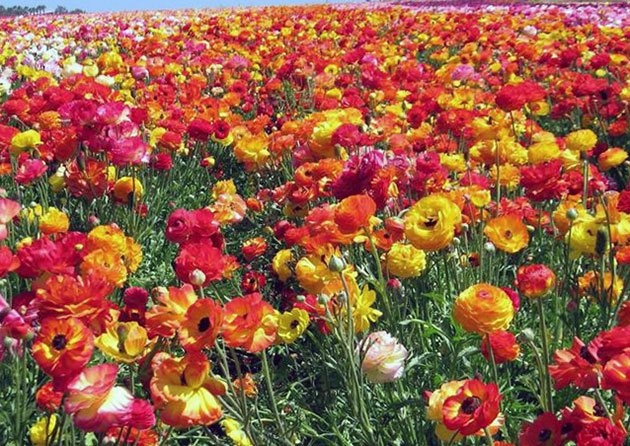
Ranunculus at home
Planting of ranunculus at home
If you want to grow ranunculus on the balcony, care for it is no more difficult than in the garden, and, nevertheless, in order to successfully grow ranunculus at home, follow the advice of experienced gardeners. It is better to plant home ranunkulus in a group and not to grow it as a single plant. Prepare or buy a decorative box or a large, wide pot with drainage holes and plant ranunculus in it. For planting you should use the same peat-based substrate as in the garden. The day before planting, soak the tubers in the water. At the bottom of the box or pot, put the drainage layer (gravel, expanded clay, egg shells), then put a layer of the substrate, place the tubers of ranunculus, add some more substrate so that you could see only the top of the bulb. If the pot is wide enough, plant a few tubers. Water ranunculus in the pot and for the first time keep it at the temperature not exceeding 54 ºF, from time to time moisten the soil.
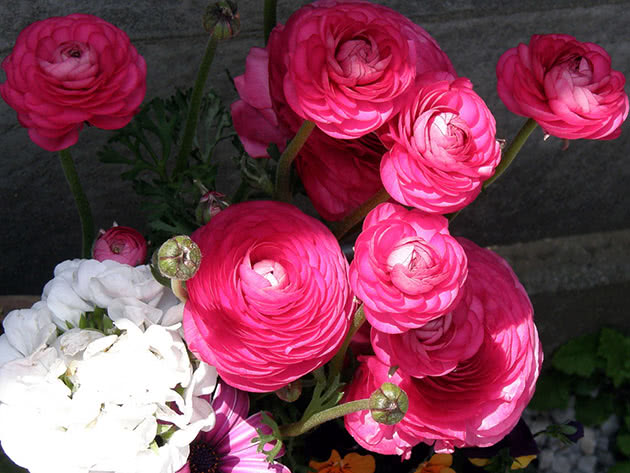
Care for ranunculus at home
When the seedlings reach a few inches, temperature may be slightly increased (up to 68-72 ºF), during flowering period it should not be below 64 ºF, but not higher, because then ranunculus at home will bloom too shortly. The most important point while caring for ranunculus at home is to avoid a direct sunlight. It feels great on the eastern and western windowsills, but if you can, place it on the south windowsill, and it will reward you with a spectacular flowering. After the onset of warm days the pot or box can be taken out to the balcony or terrace. Watering of the plant should be regular with fertilizers added to water during the growing season. Top watering is preferred, but try not overwet the soil. Sometimes the plants are sprayed with water. After withering of ranunculus watering should be reduced.
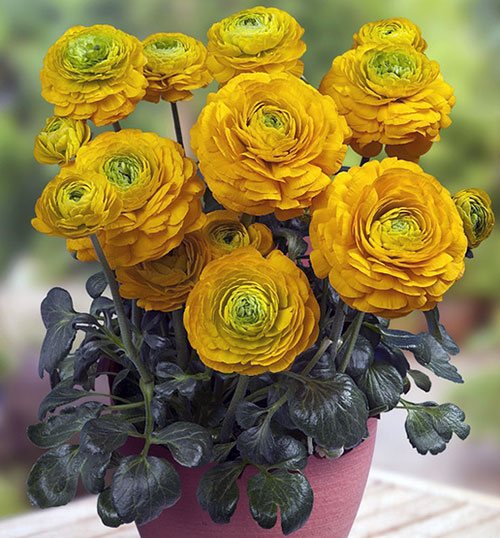
Ranunculus after flowering
Digging out and storing of ranunculus
Autumn has come. It's time to dig ranunculus out. Growing of this plant should not be time-consuming. And this concerns the last step. Once ranunculus leaves turn yellow and wither, stems and leaves are cut off and tubers of plants are removed from the ground. This should be done very carefully, since the ranunculus roots are very fragile and any careless movement can break them. Actually ranunculus is a perennial plant, but it cannot stand the temperature below -19 ºF, so it is better to overwinter in a well ventilated basement at 39-43 ºF, wrapped in dry moss or paper bag. Before placing it for winter storage, you need to process ranunculus with fungicides for 30 minutes and dry it well in the shade for three days. If your ranunkulus is perennial and there are no harsh winters in your area, leave the rhizome in the ground, just cover it with spruce branches or fallen leaves. Even if some of the tubers die, you can always buy more plants to plant in the spring.

Ranunculus at home after flowering
You can save the plant after flowering by placing it in a cool, shaded place, where ranunculus has some more time to grow. Then a dormant period comes that is preceded by the yellowing and drying of leaves and stems. Place ranunculus into the room with the temperature of 59-64 °F after transplanting it into a new soil. The dormant period lasts no more than a month, and in April you will see new shoots. Each tuber during the growing season gives 5-7 new shoots. When digging them out, they are carefully separated and planted or stored in the basement or in the refrigerator on the shelf with vegetables until spring. But it is necessary to know what ranunculus grown from stored tubers will be weaker and the flowers will be smaller. That is why many growers prefer to buy new tubers every year.
